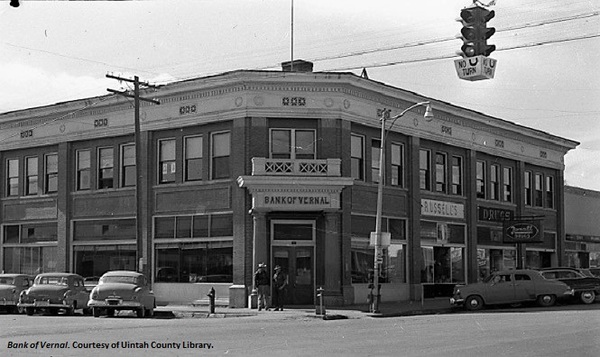Dublin Core
Title
Description
Find out why the Bank of Vernal, built in 1916, is nicknamed “The Parcel Post Bank”.
The US Post Office allows its customers to mail many things besides a simple letter. But the largest object ever moved through the US mail system was a bank. Not all at once, of course, but brick by brick.
In 1913 the Post Office created its Parcel Post Service to ship packages cheaply from door to door. The new service was ideal for rural areas, and the residents of Utah’s remote Uinta Basin took full advantage, using it to mail food, tools, auto parts, copper ore, even cement. So in 1916, when William Horace Coltharp faced the task of getting bricks to build the new Bank of Vernal, he turned to the Parcel Post Service.
The bricks that Coltharp wanted were made in Salt Lake City, located less than 150 miles from Vernal as the crow flies, but much further by freight route. Conventional freight would cost four times more than the bricks were actually worth, so Coltharp ingeniously mailed them instead for less than half the price. He ordered 80,000 bricks from the manufacturer, who carefully wrapped each one separately in newspaper and packaged them in crates weighing 50 pounds each. Forty tons of bricks were thus mailed one ton at a time.
The mail route from Salt Lake to Vernal was a circuitous 400 miles. The bricks were sent by railroad to Mack, Colorado, where the shipments were then transferred to a narrow gauge rail headed to Watson, Utah. The last leg was a 65-mile haul by wagon and cable ferry to Vernal.
The post offices were overwhelmed by the bricks, and the many delays and aggravations along the route reverberated all the way back to Washington. As a result, national postal regulations were quickly amended, and to clarify the new rules, the Postmaster General wrote that, "it is not the intent of the United States Postal Service that buildings be shipped through the mail."
But the new rules came too late to stop the shipments already underway. In the end, all 40 tons of bricks were delivered to Coltharp to build his new Bank of Vernal.
Creator
Source
Image: Bank of Vernal. c. early 1900s. Bank of Vernal on the corner of Main Street and Vernal Avenue. Bricks for this building were shipped by Parcel Post. Courtesy of Uintah County Library.
_______________
See “Parcel Post Bank”, Markers and Monuments Database, Utah Division of State History, http://history.utah.gov/research_and_collections/markers/index.html; Linda Thatcher, “Vernal's Unique Parcel Post Bank, Beehive History 6: Living and Working in Utah, 1980, p 24; Minutes of Board of State History Meeting, Rio Grande Building, Salt Lake City, Utah, September 11, 2008, accessed http://history.utah.gov/about_us/board/documents/minutes.pdf; Parcel Post Exhibit, National Postal Museum, Smithsonian Institution, Vernal Express, 1916 and 1917; Tony Servies, “The Bank That Was Sent Through the Post Office,”; for delightfully detailed treatment of the subject, see National Register of Historic Places Registration Form,

